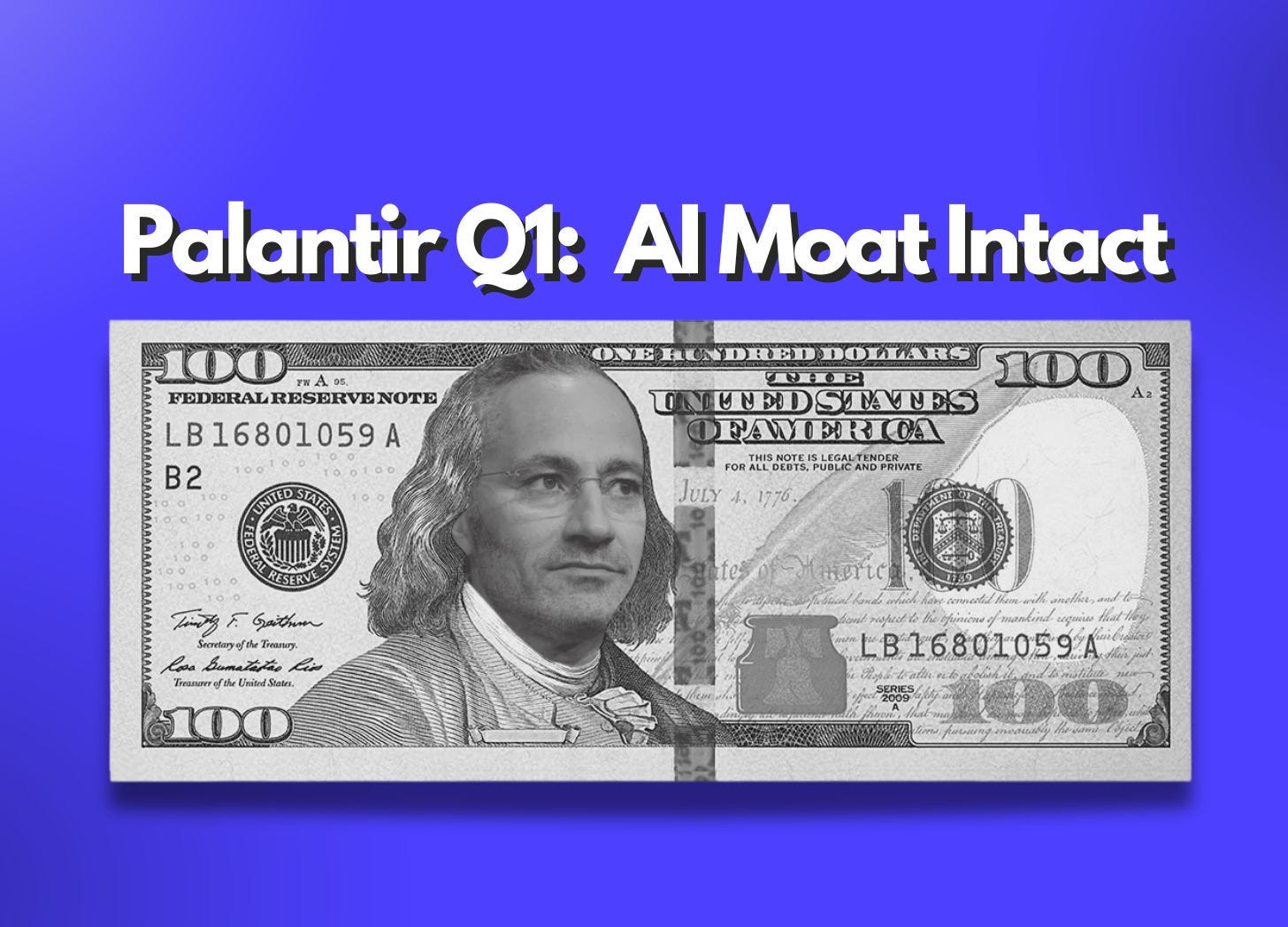Palantir Q1: The AI Moat No One Understands
Business accelerates amid macro volatility and tougher comps.
At The Pragmatic Optimist, we help investors navigate the evolving AI innovation landscape, identify rock-solid businesses with strong growth trajectories and operational grit, and make long-term investments in the space with a high probability of success.
Become a paid subscriber today
Let’s set the stage.
Since launching The Pragmatic Optimist 2.0 in mid-January, we have covered semiconductors, networking, and hyperscalers in the AI ecosystem quite extensively.
But we are yet to discuss Palantir PLTR 0.00%↑, a company that is building the AI execution layer for the new digital economy.
Often called the “Messi of the AI Revolution” , the stock has been on a tear since mid-2024, up 300% during this period of time.
Naturally, this has drawn the attention of both the bulls and bears.
While the bears often point to its nosebleed valuation of over 70x its NTM (Next Twelve Months) sales, bulls are focused on the narrative that is centered on the unrelenting demand for Palantir’s AIP (Artificial Intelligence Platform) that is spearheading enterprise autonomy, expanding federal contracts, and accelerating profitability.
Prior to Q1 FY25 earnings, investment research firm UBS had released a research report where they believed that Palantir continued to remain resilient amid a deteriorating macroeconomic environment, as their analysts had spoken to six of Palantir’s customers who indicated no intention of cutting their Palantir spend, saying that the offerings are helping them drive material cost reductions, efficiency gains, and more.
In the meantime, there were also a number of developments in the federal space that included NATO acquiring Palantir’s AI-powered military system known as Maven Smart System last month, which would embed the technology into the digital backbone of the entire continent.
The way we see it, Palantir looks a lot like Nvidia NVDA 0.00%↑ back in 2022, when the AI Revolution started with the launch of ChatGPT. What I mean is that the first wave of the AI Revolution was all about laying out the infrastructure, where Nvidia’s GPUs came into play for training LLMs.
But, we are now entering the second wave of the AI Revolution With the proliferation of reasoning models, we are about to see an explosion of companies building with AI across use cases. This is no longer about running pilots on LLMs and building out dashboards anymore. We are looking at mass AI deployment and decision loops that close in seconds.
This is where Palantir’s AIP moat delivers unmatched exceptionalism across its Commercial and Government customers, as its AI-native control layer embeds itself across the entire operating stack of a company, takes real-time data across systems, and turns it into actual simulations across business cases.
Palantir reported its Q1 FY25 earnings a couple of days ago, where its revenue acceleration trend was not only alive, but the management also raised its full-year revenue guidance to grow 35.9%, 700 basis points higher than FY24, with revenue in its Commercial revenue segment set to accelerate higher to 68%, after growing at an eye watering rate of 54% in the previous year.
What’s more, Palantir inched higher in its Rule of 40 score on a sequential basis to 83%, unmatched by any other player in the enterprise software sector.
The stock is down 12% after its earnings report.
Here’s how a Palantir bear turned bull would break down its recent earnings step by step.
Commercial business silenced all doubters.
Starting at a high level, Palantir reported $884M in Q1, up 39% YoY. This not only kept the revenue acceleration trend alive since Q2 FY23 but also beat management’s guidance by 2.7%.
During the quarter, both its Commercial and Government revenue segments accelerated by 33% and 45% to $397M and $487M, respectively.
Particularly, when it comes to its Commercial business, revenue contribution from the segment expanded by 900 basis points year-over-year to 45% as a result of accelerating AIP adoption across enterprises, with revenue from its Top 20 customers growing a whopping 26% YoY to $70M per customer.
What was even more spectacular, when it comes to its US Commercial sub-segment, revenue growth accelerated 7 points sequentially to 71% YoY, with revenue surpassing a $1B annual run rate in Q1 and its US Commercial Customer Count growing 65% YoY to 432.
For Q2, Palantir management guided for 38% YoY total revenue growth, which would mark a deceleration in the revenue trend. But, the way I see it, Palantir would need to beat the Q2 expectations by 1.3%, which, given its track record, should not be hard to achieve.
It doesn’t end there.






